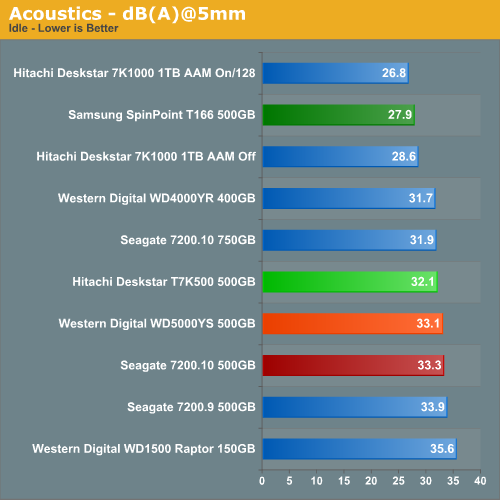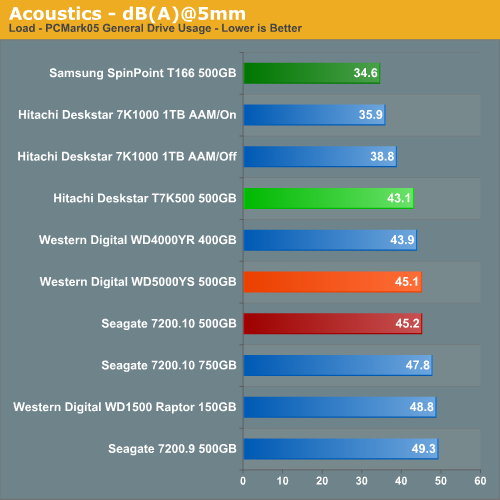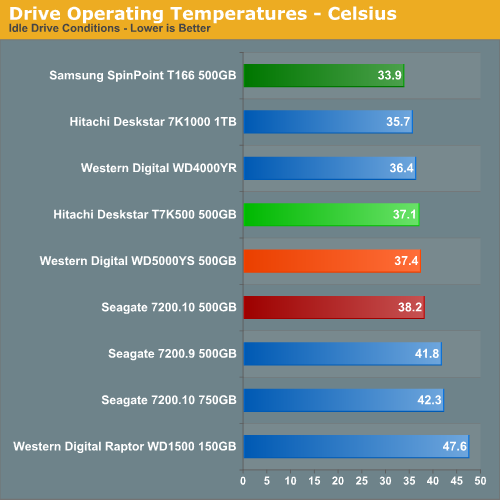Samsung SpinPoint T166 500GB: Cool, Quiet, and Quick
by Gary Key on July 9, 2007 2:00 AM EST- Posted in
- Storage
Acoustics
Our acoustic test utilizes our standard test bed components but we implement Intel's power saving technology and turn off the case fans to isolate as much case noise as possible during testing. Our Corsair power supply is nearly silent in these tests and our MSI 8800GTX video card is water cooled by an external unit to provide a further decrease in our case's ambient noise levels. Our drives are attached to the drive cage with rubber bushings to assist in isolating the noise of the drive and avoid the resulting harmonic changes due to the case design.
Our acoustic tests are designed to measure the decibel levels while the system is at idle and also under load while running the General Hard Disk Drive Usage benchmark within PCMark 2005. We found through trial and error that this particular benchmark produces controlled readings across a wide range of applications within the benchmark. This particular benchmark utilizes 60% reads and 40% writes within the trace playback file.
The measurements are taken at a distance of 5mm from the rear and front of the drive being tested in order to minimize surrounding environmental noise. We have noticed that unless we run a completely silent system in a quiet room that measurements taken from 1m are generally not meaningful due to ambient noise levels. There are exceptions like the Raptor series of drives but overall most modern desktop drives are quieter now than the other components in the system while under load.
The reported measurements are based on an A-weighted decibel score that measures frequencies similar to the way the human ear responds to sound. We take a total of three measurements for each test. We then subtract the high and low scores and arrive at our findings by reporting the remaining score.


Our Samsung SpinPoint T166 drive is extremely quiet at idle and subjectively speaking we thought it was quieter than our Hitachi 1TB drive. The drive had a slight "chirping" sound during Window's polling routine that caused the slightly higher readings. Otherwise, we found the motor noise at idle to be very soft and smooth when compared to our other drives. Our ears tell us this is the quietest drive we have tested to date although our measurements disagree.
We did not have any real issues with the drive's noise levels during light operations or under heavy loads as our measurements can attest. However, during heavy read seek operations we did notice an occasional dull but much muted tone from the drive that did not show up on our objective tests. This particular drive did have a slight vibration issue within the test case when the rubber mounting grommets were removed. In fact, the case would hum at times with this drive. Our base dB(A) level in the room at the time of testing was 25 dB(A).
Thermals
Our thermal tests utilize sensor readings via the S.M.A.R.T. (Self-Monitoring, Analysis and Reporting Technology) capability of the drives and are reported by utilizing the Active SMART 2.42 utility. We also utilize thermal sensors and infrared measurement devices to verify our utility results. We test our drives in an enclosed case environment without the fans operational to simulate temperatures that could conceivably be reached in a near silent SFF or HTPC case design. We typically find the reported numbers drop anywhere from 18% to 25% on average with the case fans operational. Our base temperature level in the room at the time of testing was 25C.


Our Samsung drive was 3.2C cooler at idle than our Hitachi T7K500 even though power consumption was slightly higher. The SpinPoint T166 also had the best load operating temperatures and the casing actually felt cooler than our readings indicated. Pardon the pun, but this is one cool drive. We saw the load temperatures drop from 45C to 38C under load conditions with the front fans operational.
Our acoustic test utilizes our standard test bed components but we implement Intel's power saving technology and turn off the case fans to isolate as much case noise as possible during testing. Our Corsair power supply is nearly silent in these tests and our MSI 8800GTX video card is water cooled by an external unit to provide a further decrease in our case's ambient noise levels. Our drives are attached to the drive cage with rubber bushings to assist in isolating the noise of the drive and avoid the resulting harmonic changes due to the case design.
Our acoustic tests are designed to measure the decibel levels while the system is at idle and also under load while running the General Hard Disk Drive Usage benchmark within PCMark 2005. We found through trial and error that this particular benchmark produces controlled readings across a wide range of applications within the benchmark. This particular benchmark utilizes 60% reads and 40% writes within the trace playback file.
The measurements are taken at a distance of 5mm from the rear and front of the drive being tested in order to minimize surrounding environmental noise. We have noticed that unless we run a completely silent system in a quiet room that measurements taken from 1m are generally not meaningful due to ambient noise levels. There are exceptions like the Raptor series of drives but overall most modern desktop drives are quieter now than the other components in the system while under load.
The reported measurements are based on an A-weighted decibel score that measures frequencies similar to the way the human ear responds to sound. We take a total of three measurements for each test. We then subtract the high and low scores and arrive at our findings by reporting the remaining score.


Our Samsung SpinPoint T166 drive is extremely quiet at idle and subjectively speaking we thought it was quieter than our Hitachi 1TB drive. The drive had a slight "chirping" sound during Window's polling routine that caused the slightly higher readings. Otherwise, we found the motor noise at idle to be very soft and smooth when compared to our other drives. Our ears tell us this is the quietest drive we have tested to date although our measurements disagree.
We did not have any real issues with the drive's noise levels during light operations or under heavy loads as our measurements can attest. However, during heavy read seek operations we did notice an occasional dull but much muted tone from the drive that did not show up on our objective tests. This particular drive did have a slight vibration issue within the test case when the rubber mounting grommets were removed. In fact, the case would hum at times with this drive. Our base dB(A) level in the room at the time of testing was 25 dB(A).
Thermals
Our thermal tests utilize sensor readings via the S.M.A.R.T. (Self-Monitoring, Analysis and Reporting Technology) capability of the drives and are reported by utilizing the Active SMART 2.42 utility. We also utilize thermal sensors and infrared measurement devices to verify our utility results. We test our drives in an enclosed case environment without the fans operational to simulate temperatures that could conceivably be reached in a near silent SFF or HTPC case design. We typically find the reported numbers drop anywhere from 18% to 25% on average with the case fans operational. Our base temperature level in the room at the time of testing was 25C.


Our Samsung drive was 3.2C cooler at idle than our Hitachi T7K500 even though power consumption was slightly higher. The SpinPoint T166 also had the best load operating temperatures and the casing actually felt cooler than our readings indicated. Pardon the pun, but this is one cool drive. We saw the load temperatures drop from 45C to 38C under load conditions with the front fans operational.










42 Comments
View All Comments
Final Hamlet - Thursday, July 12, 2007 - link
Why bother buying the out-dated T166 model if the F1 is entering the market as we're speaking?Just judging after the 1Tera Hitachi it will be more silent, less warm and the 500GB model has only 2 platters instead of 3.
[I don't want to speak badly of Samsung HDs, as I have a T166 and a T133, but why bother buying the old generation?]
TA152H - Monday, July 9, 2007 - link
You've got guts buying a Crashtor, and if it actually a Seagate, count yourself lucky. But, you probably have a Crashtor or some mixture. Seagate has properly relegated it to the low end segment, but they also said when they bought them that Maxtor had better perpendicular recording technology. I don't know what that means exactly, but your hard disk might truly be befouled by Maxtor genetics. Back up early and often. Hmmm, maybe that should have been Crashtor's moto. It's catchy.